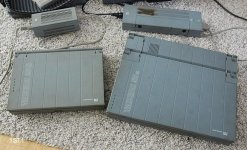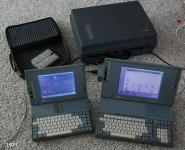Upcoming Events:
- VCF South West - June 14 - 16, Davidson-Gundy Alumni Center at University of Texas at Dallas
- VCF West - Aug 2 - 3, Computer History Museum, Mountain View, CA
- VCF Midwest - Sept 7 - 8 2024, Schaumburg, IL
- VCF SoCal - Mid February 2025, Location TBD, Southern CA
- VCF East - April 2025, Infoage Museum, Wall NJ
-
Please review our updated Terms and Rules here
You are using an out of date browser. It may not display this or other websites correctly.
You should upgrade or use an alternative browser.
You should upgrade or use an alternative browser.
First Laptops with Touchpad as Mouse replacement?
- Thread starter 1ST1
- Start date
smeezekitty
Experienced Member
Holy crap what's with the burn mark on the power supply on the right one?
kyodai
Experienced Member
Interesting question. I always thought the IBM PC-110 was pretty early with its "digitizer". back in the days only a custom made driver could turn the digitizer into a touchpad. But these seem to be much earlier.
1ST1
Veteran Member
The IBM PC110 came out in 1995 (and was started to develop in 1991/92) as I just found out from Thinkpad Wiki. Those TA-Olivetti were already sold in 1992. These touchpads are not working by capacity, but by soft pressure. The larger notebook has a plastics pen which is clipped in the display frame to use the touchpad more precise, but there is not much difference with the finger.
The burn mark was some filter capacitor which have been too weak for today's 230V power outlets. Luckyly the fuse in my house answered early enough to prevent a larger fire. Now these 250V type filter capacitors are replaced by 275V type and it's good now. I have to do the same with the smaller power supply as well. One has to be carefull with such old hardware, always some surprises can happen.
The burn mark was some filter capacitor which have been too weak for today's 230V power outlets. Luckyly the fuse in my house answered early enough to prevent a larger fire. Now these 250V type filter capacitors are replaced by 275V type and it's good now. I have to do the same with the smaller power supply as well. One has to be carefull with such old hardware, always some surprises can happen.
The IBM PC110 came out in 1995 (and was started to develop in 1991/92) as I just found out from Thinkpad Wiki. Those TA-Olivetti were already sold in 1992. These touchpads are not working by capacity, but by soft pressure. The larger notebook has a plastics pen which is clipped in the display frame to use the touchpad more precise, but there is not much difference with the finger.
The burn mark was some filter capacitor which have been too weak for today's 230V power outlets. Luckyly the fuse in my house answered early enough to prevent a larger fire. Now these 250V type filter capacitors are replaced by 275V type and it's good now. I have to do the same with the smaller power supply as well. One has to be carefull with such old hardware, always some surprises can happen.
Ha, I had a 250V filter capacitor explode inside my TRS-80 Model 4P recently, and that was on a 115V circuit. Sometimes they just get old and deteriorate past the point where they can hold up at any voltage.
1ST1
Veteran Member
I initially replaced the capacitor with exactly the same type, result was that after a few minutes it burnt again. So I took stronger type and it was good then.
ropersonline
Experienced Member
- Joined
- Jun 17, 2011
- Messages
- 153
There were a few laptops that experimented with touchpad technology earlier on, but the first widely available ones where the touchpad was positioned and worked like in modern laptops were the Apple PowerBook 500 series machines (1994).
https://en.wikipedia.org/wiki/Touchpad#History
Apple's PowerBooks had also previously pioneered modern notebook layout/design with their first, PowerBook 100 series (1991).
The GRiD Compass (1982) had come close too, but its hinge was more towards the middle than the back, and the keyboard was still right up front (I'm not even sure if it ever had a pointing device). Oh, and the Compass cost more than the average US car in 1982.
Anyway, after the PowerBook 100 series, pretty soon just about all laptops started arranging their components that way.
https://en.wikipedia.org/wiki/Touchpad#History
Apple's PowerBooks had also previously pioneered modern notebook layout/design with their first, PowerBook 100 series (1991).
The GRiD Compass (1982) had come close too, but its hinge was more towards the middle than the back, and the keyboard was still right up front (I'm not even sure if it ever had a pointing device). Oh, and the Compass cost more than the average US car in 1982.
Anyway, after the PowerBook 100 series, pretty soon just about all laptops started arranging their components that way.
krebizfan
Veteran Member
The Gavilan SC had a rudimentary touchpad back in 1983. The Powerbook was not the first with the hinge in the back; lowly Compaq's LTE did it two years earlier as did NEC's Ultralite.
Can you consider touchscreens to be equivalent to touchpads except for placement? If so, HP might qualify because I think one of their mid-80s laptop designs included an optional smaller version of the touchscreen used in the HP-150 series.
Can you consider touchscreens to be equivalent to touchpads except for placement? If so, HP might qualify because I think one of their mid-80s laptop designs included an optional smaller version of the touchscreen used in the HP-150 series.
1ST1
Veteran Member
I think the position of the touchpad (or vectorpad as on ST-Book, Trackpoint on Thinkpads or trackball on Powermac) has to do with the mainly expected operating system to be used on the laptop. These TA-Olivettis came out in a time when MS-DOS still was the most important OS for PC, so user interface was based more on keyboard than mouse. So it maked sense to put the keyboard in the front on these thick devices. In 1992 Windows 3.x just started to get popular. On the other side, Powermac came with graphical UI by default, so it's more logical to place the touchpad in front of the keyboard as the machine mostly is used by mouse. (That's also what I don't like on ATARI ST Book, it has the vector pad in the same position as the TA-Olivetti's touchpad, for righthand users quite Ok, for lefthand use almost impossible, but the vector pad is very important to use that GEM machine.) Later Olivetti Philos 33 (click had a trackball right of the keyboard, similar to that addon trackball from Logitech wich could be glued to the laptop's side, but Olivett's trackbnall was snapping in and out of the notebooks chassis, very courious and creative. Later Olievtti Echos series first had trackpoint and then later capacitive touchpad in front of the keyboard as they were already designed to run by default under WFW 3.11 and Win 95.
ropersonline
Experienced Member
- Joined
- Jun 17, 2011
- Messages
- 153
I think the position of the touchpad (or vectorpad as on ST-Book, Trackpoint on Thinkpads or trackball on Powermac) has to do with the mainly expected operating system to be used on the laptop. These TA-Olivettis came out in a time when MS-DOS still was the most important OS for PC, so user interface was based more on keyboard than mouse. So it maked sense to put the keyboard in the front on these thick devices. In 1992 Windows 3.x just started to get popular. On the other side, Powermac came with graphical UI by default, so it's more logical to place the touchpad in front of the keyboard as the machine mostly is used by mouse. (That's also what I don't like on ATARI ST Book, it has the vector pad in the same position as the TA-Olivetti's touchpad, for righthand users quite Ok, for lefthand use almost impossible, but the vector pad is very important to use that GEM machine.) Later Olivetti Philos 33 (click had a trackball right of the keyboard, similar to that addon trackball from Logitech wich could be glued to the laptop's side, but Olivett's trackbnall was snapping in and out of the notebooks chassis, very courious and creative. Later Olievtti Echos series first had trackpoint and then later capacitive touchpad in front of the keyboard as they were already designed to run by default under WFW 3.11 and Win 95.
IMNSHO, the biggest plus of not putting the keyboard right up front isn't that you can then put a pointing device there, it's ergonomics.
Putting they keyboard in the back near the hinge puts the screen closer to your eyes and some support under your wrists.
The Gavilan SC had a rudimentary touchpad back in 1983. The Powerbook was not the first with the hinge in the back; lowly Compaq's LTE did it two years earlier
Yes, but these didn't have the combination of keyboard and screen hinge in the back plus modern pointing device (placement). Close, but no cigar.
as did NEC's Ultralite.
I think that machine —which I don't recall seeing before— also comes somewhat closer to the modern laptop form factor. It looks neat and gets some likeness points.
Can you consider touchscreens to be equivalent to touchpads except for placement? If so, HP might qualify because I think one of their mid-80s laptop designs included an optional smaller version of the touchscreen used in the HP-150 series.
I would say, hell no. Vertical touchscreens are good for vending machines and similar control panels, but turning a regular monitor into a touchscreen is not an ergonomic pointing device replacement, because you need to hover your arm. And even if what you recall was a horizontally placed desk-top flat panel touchscreen: that's closer to a tablet – those have their uses, but at least back then, the display capabilities of touchscreens (and they weren't as good as today's) would have been expensive and wasted on simple pointing device usage. That's changed now though, and we may actually see more "screenification" of touchpads – and even keyboards, given some advances in tactile feedback. (I have long had some ideas on this, but I lack resources and know-how to turn them into something real.)
Last edited:




